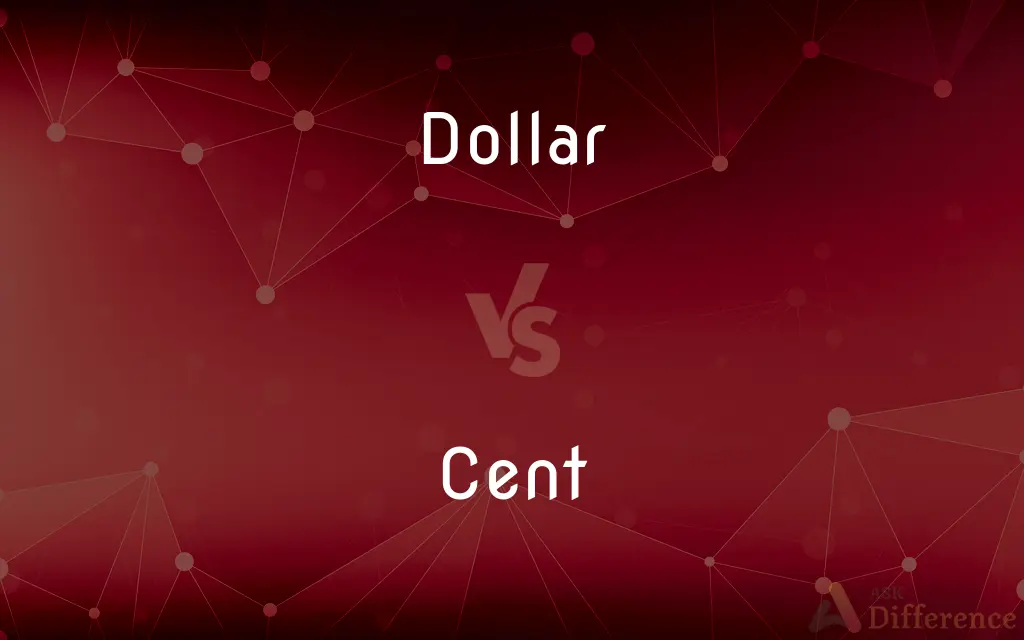Dollar vs. Cent — What's the Difference?
By Tayyaba Rehman — Updated on September 28, 2023
Dollar is a unit of currency used in various countries, symbolized by "$"; Cent is a subunit of the dollar, worth one-hundredth of a dollar, symbolized by "¢."

Difference Between Dollar and Cent
Table of Contents
ADVERTISEMENT
Key Differences
Dollar and Cent are both units of currency but represent different values in the monetary system. A Dollar is a principal unit of currency used predominantly in many countries including the United States, symbolized by “$”. It is typically the basic monetary unit and is subdivided into smaller units. In countries that use dollars, goods, services, and transactions are commonly priced in dollars, reflecting its role as the standard measure of value.
In contrast, a Cent is a subunit of the dollar, symbolized by “¢”. One dollar is equivalent to one hundred cents. The cent is used to represent smaller values and transactions, allowing for more precise pricing and valuation. When dealing with prices and transactions, the value in cents is often used when the amount is less than one dollar or to specify amounts not whole dollars.
While the dollar is the standard unit of currency, used for higher and rounded-off values, the cent is instrumental for lower values and exact amounts. A dollar is usually represented by bills or coins of larger denominations, and a cent is typically represented by smaller coins. In everyday transactions, people use both dollars and cents, depending on the value of the transaction and the precision required in specifying amounts.
The concept of dollar and cent is fundamental to understanding and navigating the monetary system in countries that use this form of currency. Knowing the value and relationship between a dollar and a cent is crucial for accurate financial transactions, budgeting, and financial planning. It allows individuals to manage and allocate their resources effectively, facilitate trade and commerce, and participate in economic activities.
Comparison Chart
Unit of Measurement
Principal unit of currency.
Subunit of the dollar.
ADVERTISEMENT
Value
Equivalent to one hundred cents.
One-hundredth of a dollar.
Symbolization
Represented by the symbol "$".
Represented by the symbol "¢".
Usage
Used for higher and rounded-off values.
Used for lower values and exact amounts.
Denomination
Represented by bills or larger denomination coins.
Typically represented by smaller denomination coins.
Compare with Definitions
Dollar
A basic monetary unit used in many countries, symbolized by "$".
She earned twenty dollars for her work.
Cent
Utilized for transactions less than one dollar or non-whole dollar amounts.
He needed a few cents more to make a dollar.
Dollar
A currency unit equivalent to one hundred cents.
He exchanged his euros for dollars before the trip.
Cent
Allows for valuation of goods and services in smaller increments.
She saved every cent she earned.
Dollar
Used for pricing goods and services in countries adopting it.
The laptop costs five hundred dollars.
Cent
Represents smaller values and precise pricing in the monetary system.
The candy costs fifty cents.
Dollar
Represented by bills and coins of varying denominations.
She paid him in one-dollar bills.
Cent
Integral for specifying exact amounts in pricing and transactions.
Every cent counts when budgeting tightly.
Dollar
Reflects the standard measure of value in the monetary system.
The value of a dollar has fluctuated over the years.
Cent
A coin worth one-hundredth of a dollar, symbolized by "¢".
He gave a nickel and three cents.
Dollar
Dollar (symbol: $) is the name of more than 20 currencies. They include the Australian dollar, Brunei dollar, Canadian dollar, Hong Kong dollar, Jamaican dollar, Liberian dollar, Namibian dollar, New Taiwan dollar, New Zealand dollar, Singapore dollar, United States dollar, and several others.
Cent
A unit of currency equal to 1/100 of various currencies, including the US dollar and the euro.
Dollar
See Table at currency.
Cent
(money) A subunit of currency equal to one-hundredth of the main unit of currency in many countries. Symbol: ¢.
Dollar
A coin or note that is worth one dollar.
Cent
(informal) A small sum of money.
He blew every last cent.
Dollar
Any of various historical silver coins similar to the taler, such as a piece of eight.
Cent
(money) A subunit of currency equal to one-hundredth of the euro.
Dollar
Money spent or available to be spent
Boardwalk shops competing for the tourist dollar.
Cent
(money) A coin having face value of one cent (in either of the above senses).
Dollar
Official designation for currency in some parts of the world, including Canada, the United States, Australia, New Zealand, Hong Kong, and elsewhere. Its symbol is $.
Cent
(music) A hundredth of a semitone or half step.
Dollar
(by extension) money generally.
Cent
(nuclear physics) A unit of reactivity equal to one hundredth of a dollar.
Dollar
A quarter of a pound or one crown, historically minted as a coin of approximately the same size and composition as a then-contemporary dollar coin of the United States, and worth slightly more.
Cent
Abbreviation of century
Dollar
Imported from the United States, and paid for in U.S. dollars. (Note: distinguish "dollar wheat", North American farmers' slogan, meaning a market price of one dollar per bushel.)
Cent
Abbreviation of centumOne hundred.
Dollar
(nuclear physics) A unit of reactivity equal to the interval between delayed criticality and prompt criticality.
Cent
Abbreviation of centigrade
Dollar
A silver coin of the United States containing 371.25 grains of silver and 41.25 grains of alloy, that is, having a total weight of 412.5 grains.
Cent
Abbreviation of center
Dollar
A coin of the same general weight and value as the United States silver dollar, though differing slightly in different countries, formerly current in Mexico, Canada, parts of South America, also in Spain, and several other European countries.
Cent
A hundred; as, ten per cent, the proportion of ten parts in a hundred.
Dollar
The value of a dollar; the unit of currency, differing in value in different countries, commonly employed in the United States and a number of other countries, including Australia, Canada, Hong Kong, parts of the Carribbean, Liberia, and several others.
Cent
A United States coin, the hundredth part of a dollar, formerly made of copper, now of copper, tin, and zinc.
Dollar
The basic monetary unit in many countries; equal to 100 cents
Cent
An old game at cards, supposed to be like piquet; - so called because 100 points won the game.
Dollar
A piece of paper money worth one dollar
Cent
A fractional monetary unit of several countries
Dollar
A United States coin worth one dollar;
The dollar coin has never been popular in the United States
Cent
A coin worth one-hundredth of the value of the basic unit
Dollar
A symbol of commercialism or greed;
He worships the almighty dollar
The dollar sign means little to him
Common Curiosities
Is the symbol for dollar always "$"?
While "$" is commonly used to represent the dollar, some countries might have variations or additional symbols.
Is the dollar the principal unit of currency in all countries?
No, the dollar is the principal unit only in countries that have adopted it as their standard currency.
Is the value of a dollar constant?
No, the value of a dollar can fluctuate due to economic conditions like inflation and exchange rates.
Are cents important in pricing goods and services?
Yes, cents are crucial for exact pricing and often used in pricing strategies to denote value.
Can cents be used to represent amounts larger than a dollar?
Yes, cents can represent amounts larger than a dollar, but it’s more common to use dollars for such amounts for simplicity.
Can cents be represented by bills?
Typically, cents are represented by coins, not bills, due to their lower value.
Can a cent be subdivided into smaller units?
Typically, a cent is the smallest unit of currency and is not subdivided in everyday transactions.
Is a dollar always equivalent to one hundred cents?
Yes, a dollar is universally equivalent to one hundred cents.
Is the term "dollar" used universally to represent the same amount of value?
No, the value of a dollar can vary significantly between different countries' currencies.
Can you pay in cents for any amount?
In theory, yes, but it's impractical for large amounts due to the physical bulk of coins.
Do all countries using dollars also use cents as a subunit?
Most countries using the dollar as their currency also use cents as a subunit, but there might be exceptions or variations in naming.
Share Your Discovery

Previous Comparison
Police vs. Cop
Next Comparison
Moat vs. MoteAuthor Spotlight
Written by
Tayyaba RehmanTayyaba Rehman is a distinguished writer, currently serving as a primary contributor to askdifference.com. As a researcher in semantics and etymology, Tayyaba's passion for the complexity of languages and their distinctions has found a perfect home on the platform. Tayyaba delves into the intricacies of language, distinguishing between commonly confused words and phrases, thereby providing clarity for readers worldwide.














































